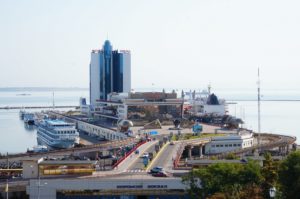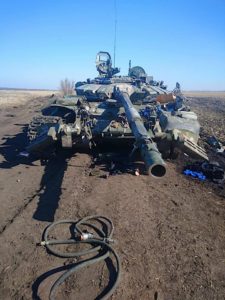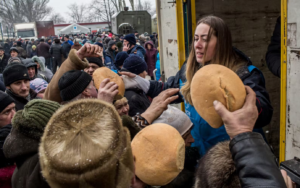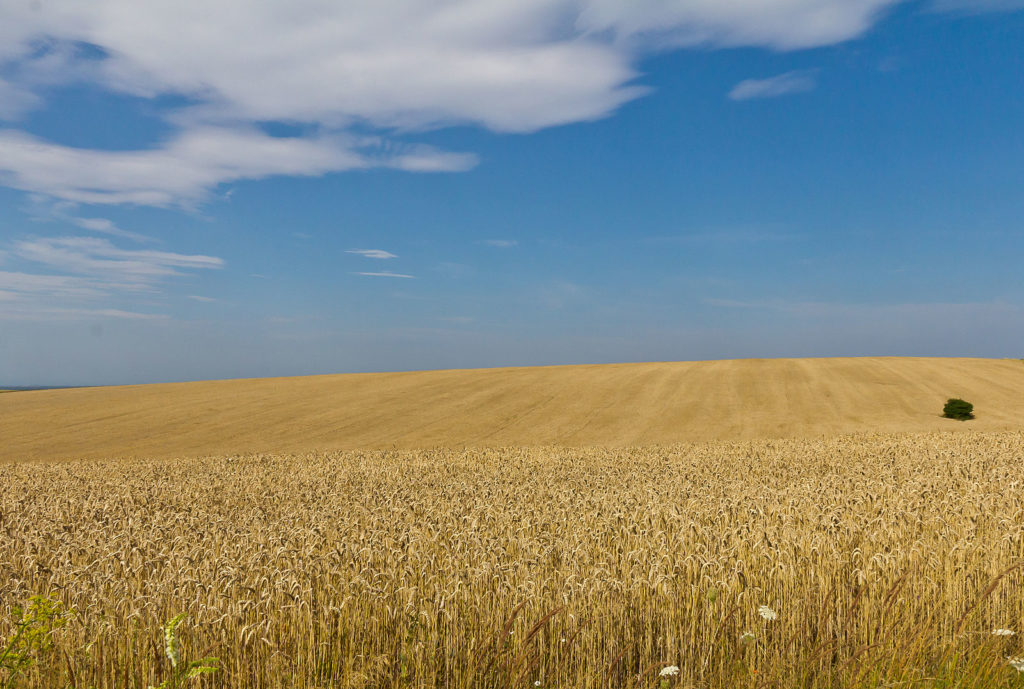Ukrainian wheat fields on fire © Sesu
On February 24, 2022 following the Russian invasion of Ukraine, millions of people were forced to flee the country or to relocate to other cities and towns. Since then, roads have been bombed, cities destroyed, and people left isolated with no food or water. In this grim situation, it is impossible to imagine that things can go on as usual in any aspect of everyday life. The people of Ukraine cannot go about their lives normally and life in general has to suffer. The economy too. The rapid economic decline will most likely be felt far beyond Ukraine’s borders. The consequences of this terrible war in the middle of Europe will spread all around and beyond the continent, threatening millions with hunger.
Because of Ukraine’s important status on the agricultural global market, the present situation may severely affect the welfare of millions, even for years to come. Decisions must be taken now and fast, in order to avoid a greater disaster.

In recent years Ukraine has produced around 10% of all wheat exports and 50% of the sunflower oil exports. That is why the Russian invasion of this country is seen as a major concern not only from a political, military and humanitarian point of view, but also from an agricultural perspective, as it is most likely that it will affect and impact the stability of the global food system.
Wheat is a widely cultivated crop, especially in temperate climates, with a short growing season. Its grains are used to make bread, an essential food all over the world. It is believed that cultivating wheat started in Turkey, about 10,000 years ago. This plant was cultivated for its seeds, from which people started making bread and other foods. Syria, Iraq and later Greece, Cyprus and Egypt became important producers. Egypt is credited to be the first large scale grain producer. Later on, wheat cultivation spread to Europe, China and the Americas. What was originally a ‘high-status’ food, became gradually a mass consumption good. Over times, the cropping techniques improved significantly and the results became increasingly satisfying. Crop rotation, the use of fertilizers and mechanization made it one of the most cultivated food crops on earth. In order to be used by humans, wheat needs processing. The harvested seeds are turned mostly into flour (three quarters of all crops) and other products, like malt, starch or dextrose. A large variety of present day foods come from wheat: bread, crackers, biscuits, noodles and pasta, muesli, semolina, beer, vodka or breakfast cereals. Wheat is a major source of carbohydrates, with also about 13% proteins and lots of dietary fibers, B vitamins and minerals. Wheat is also an important energy source: 100 grams of wheat provide 324 calories. However, gluten, one of the proteins in wheat, may cause gluten intolerance and problems for people having the Celiac disease.

As one of the most cultivated grains in the world today, wheat has a strategic importance. The global wheat trade is higher than other crops put together. Russia and Ukraine make about 30% of the global wheat trade. While a strict embargo on Russian imports was imposed in many countries as a response to its military actions, one of the top suppliers is out of the stage. So we will now see the consequences. “The price of these sanctions is not just imposed upon Russia. It’s imposed upon an awful lot of countries as well, including European countries. Both Russia and Ukraine have been the bread basket of Europe in terms of wheat, for example” said US president Biden on March 24, 2022.
Globally, China is the world’s largest wheat producer, with 134,254,710 tons per year. It plays an important role in shaping the grain market dynamics and prices. Russia ranks 3rd, after China and India, with 85,896,326 tons of wheat (Source: Worldpopulationreview.com). These first three producers combined count for 41% of the world’s total wheat production. The European Union would rank 2nd on the list, if it were counted as a single market. FAO (Food and Agriculture Organization of the United Nations) estimates that Russia is the top wheat exporter, as China and India consume most of their huge production domestically.
In 2020, Ukraine was number 8 on the list, with almost 10% of the market. The majority of its crops are planted in the south-central regions of the country. Ukraine cultivates mostly a type of wheat used for bread making. Over the last few years, Ukraine has increased its production and exports with almost 40%. But considering the current war situation in the country, much of Ukraine’s crops have probably been compromised for at least one season. Its minister of agriculture officially declared that the country has reduced its grain exports to a tenth compared to March 2021. It is also a problem of logistics. Even if the crops were to be harvested with a largely destroyed transport infrastructure, the country will find it terribly difficult, if not impossible, to fulfill its international contracts and agreements. With fuel and fertilizers (which were mostly imported from Russia, as a major producer) in very short supply these days, the Ukrainian farmers who haven’t fled the country or gone to war, will find it difficult to continue ‘life as usual’ and harvest and cultivate crops as in peaceful times. The food chains are also most likely broken.

Before the war, Ukraine delivered 98% of its grain via the Black Sea. Odessa is Ukraine’s biggest port on the Black Sea, and the main gate to Ukrainian foreign trade but it has been completely blocked by Russian warships since early March and has also been bombed for the last few weeks. So, the majority of the commercial ships which were normally to dock there are now heading to Constanta, the largest Romanian port in the region which is already overcrowded.
Another option for transporting grains from Ukraine could be by train. With a rail system of around 22,300 km, rail freight might be an option as Ukraine attracted high volumes of goods transiting the country on the ‘New Silk Road’ from Asia to Europe in recent years. In January 2020, during a speech, China’s president Xi Jinping expressed the importance of the Chinese-Ukrainian strategic relationship in this regard. But as war broke out in late February, these transit routes were no longer possible and everyone had to seek alternative routes in order to avoid the devastated country. The Ukrainian Railways, controlled by the government, entered an emergency mode. The new alternative transport routes for Asia to Europe go through the Black Sea, linking the Georgian port of Poti to Constanta in Romania, from where goods could continue by road to Europe or by ship to other destinations.

Kyiv authorities recently discussed with Romania the possibility of delivering agricultural products to the port of Constanta via the Danube ports, although the whole process is a complex and expensive one. According to the consulting firm APK-Inform, ‘the cost of delivering grain from Ukraine to the port of Constanta would be 120-150 Euros per ton. By comparison, before the war, traders paid between 20 and 40 US dollars per ton, to transport grains to Ukrainian ports on the Black Sea.’ (Source: G4media.ro).
The road and train alternatives are not as easy as they seem. Only these days, more than 24,000 wagons of Ukrainian export goods are stranded on the border with Poland due to insufficient number of vehicles and gauge differences between the railways of the two countries. Reuters Press agency noted that about 1,100 grain-loaded train cars were stranded in western Ukraine, near the main rail transit point on the border with Poland, from where they could continue to Gdansk, the Polish port. These difficulties are exacerbated by logistical problems, such as the gauge difference between the railways in Ukraine, a legacy of the former USSR, and those in neighboring countries, such as Poland and Romania. Because the gauge of railways in Ukraine is about 1.5 meters, 10 centimeters larger than in Europe, railway staff has to lift each wagon and replace the chassis with a suitable one for the railways in the west. An alternative could be to empty the grains from the Ukrainian wagons and put them into new ones, but this procedure could take up to 30 minutes for each wagon. The Ukrainian railway company is working to increase capacity so that within three months, up to 1,100 grain wagons will cross the border into Poland, Romania, Hungary and Slovakia on a daily basis, assured a Ukrainian official. However, the delays, waiting times and costs will probably still be high. Many are pessimistic about the evolution of the situation. They say that even if the country manages to rapidly increase its exports of agricultural products by railway via Danube canals and through the ports of neighboring countries, it would still be only 10-15% of the needed capacity.

In Europe, France (30 million tons), Germany (22 million tons), Poland (12 million tons), Spain (8 million tons) and Romania (7 million tons) are the largest wheat producers, and the European Union hopes that they will be able to compensate, at least partly, the lack of supply from Ukraine.
But one of the major shockwaves on the wheat market will be felt not in Europe, but in Africa! The continent has a very high wheat consumption level and very little cultivated areas, certainly not enough. Egypt is the main wheat producer in Africa, with 9 million tons in 2020, but it is also the largest wheat importer in the world, with around 13 million tons each year. Egypt spends around 4 billion US dollars on wheat imports each year, to feed its 100 million citizens. Morocco produces around 2.6 million tons per year, but these production values are far too little to cover the African needs. Africa imports most of its wheat, vital for survival in many areas, from Russia, France and Ukraine. Wheat imports accounted for almost 1.5 billion US dollars in 2020. Russian and Ukrainian imports cover up to 30% of all African wheat consumption (Source: Statista.com). As prices of wheat are going up, many poor countries cannot simply afford to supply the much needed grains. And this might lead to social unrest and higher migration numbers from these areas to Europe. There is always a close link between soaring food prices and political instability in such areas, as it has already been proven before.
Oil prices are up, so food prices will also go up. Wheat prices have already risen to their highest level since 2008, 20% higher than normal. It is now vital that crops in 2022 will be at least above average, in order to try to compensate the vacuum on the market. The record wheat price was registered on March 7,, 2022 but optimistic forecasts of high production levels in North-America and Asia slightly lowered the grain quotations.

Sunflower seeds are another crop which is expected to be affected this year, because of war. Russia and Ukraine have been traditionally the world’s top producers for years. In 2019, the total global production was around 56 million tons, with Ukraine and Russia counting for approximately 55% of it. In 2021, Ukraine, the ‘sun flower country’, was the top global producer, with 17.5 million tons alone. (Source: Statista.com). Argentine, with 3.4 million tons, Romania (which is the leading producer within the European Union), with 3.3 million tons, and China are also big players on this market, but the difference in numbers, as you can easily see, is huge. Ukraine was also the largest sunflower oil exporter. In 2019 they exported oil for around 3.8 billion US dollars worth. Over the last ten years, Ukraine’s production doubled. Its main advantage, as compared for example to its neighbor, Romania, is that Ukraine processes almost all the raw sunflower seeds domestically and sells the oil afterwards.
Worldwide, sunflower oil is largely used as cooking oil because it has a higher burning point than other kinds of oils. It has been proven that it may lower the risk of heart disease; it lowers the ‘bad’ cholesterol LDL and raises the good one, HDL. Sunflower oil is possibly not as tasty as olive oil, but it is cheaper. Used daily in many homes, it is almost as essential as wheat. The fear of potential sunflower oil shortages spread quickly in March, after war broke out in Ukraine.

India is the top sunflower oil importer, getting it mostly from Ukraine. European Union also imports significant quantities from outside the Union and the recent events have caused a significant increase in sunflower oil prices, and ultimately led to an ‘oil rush’ in stores across Europe, similar to the previous ones, related to flour, yeast or even toilet paper during the pandemic. Images on news programs of people buying large quantities or empty shelves in stores became commonplace. Prices went up and are sadly expected to further rise sharply, as the supply is small and the war in Ukraine doesn’t seem to be coming to an end soon. Ukrainian farmers must quickly look for reliable alternatives to transport their production, or what’s left of it, once it’s harvested.
As a response to all the economic sanctions imposed by the West, Russia recently announced new export top quotas of 1.5 million tons on sunflower oil, starting April 15, and banned all seed shipments. The restrictions, announced by the Russian Ministry of Agriculture will be in place at least until the end of August 2022. Russia also imposed a 700,000 tons export quota on sunflower meal (a product obtained from crushing the sunflower seeds). On March 14, Russia announced the first restrictions on grain exports, with its declared purpose to avoid domestic shortages in supplies.
As a forced reaction to the current situation and fears, many food producers declared that they will turn to using palm oil as a replacement, although this is sometimes considered not as healthy, and its production process not eco-friendly.
The turmoil on agricultural markets these days causes uncertainty and serious concerns in many political and economic circles. The food supply shortages may cause big troubles, especially in poor countries, with little or no essential crop production. World Food Program (WFP, a 2020 Nobel Peace Prize winner and the world’s largest humanitarian organization) estimates that “in 8 out of 10 of the worst hunger crises, conflict is one of the main drivers”. They also signaled that “the Black Sea basin is one of the world’s most important areas for grain and agricultural production, and the food security impact of the conflict will likely be felt beyond Ukraine’s borders”.

“We get 50 percent of our grains out of the Ukraine-Russia area; it’s going to have a dramatic impact on food costs, shipping costs, oil and fuel. This is a catastrophe on top of a catastrophe”, said WFP Executive Director David Beasley in a social media video, posted from Yemen. (www.wfp.org)
But how can we fight or alleviate the current situation?
Besides the obvious, immediate need to stop the war in the region and help Ukraine rebuild the country, the world should concentrate on maximizing other existing agricultural areas. Boosting the existing crops and redirecting them with priority to where they are most urgently needed should be on the top of the list of decision makers worldwide.
Environmental activists warn that exploitations of new areas through further, disastrous deforestation should be avoided. They advise that using bio-energy instead of Russian gas, redirecting the bio fuel crops to human consumption for a short period and reducing the great amount of food waste are viable, efficient and quick possible solutions. “I only feel anger when I see waste” said Mother Theresa a long time ago. Today, about one-third of the total food produced in the world for human consumption (approximately 1.3 billion tons) is lost or wasted each year.

People everywhere, and especially in rich countries which do not face the lack of food yet, should be aware of what food really means, of its importance and real value. Waste and overconsumption are problems that have been insistently reported for years. Out of the world population, one in nine still does not have enough to eat and 44 million people are at risk of famine. In the long run, this will lead to even more ecological disasters as well as social unrest and greater forced migration. Nobody knows when and how the war in Ukraine will end, as daily discoveries of war crimes and ongoing situations seem to undermine all planning. In difficult times such as the present one, there is a real need for true solidarity between countries.
“The Earth is what we all have in common” (Wendell Berry, American novelist).

